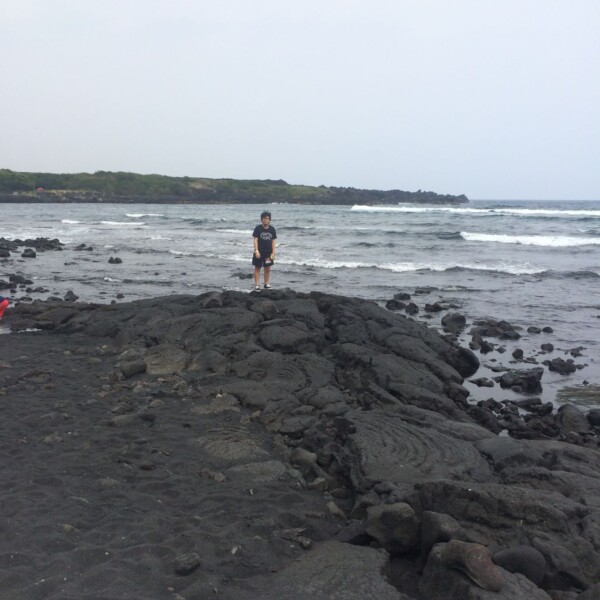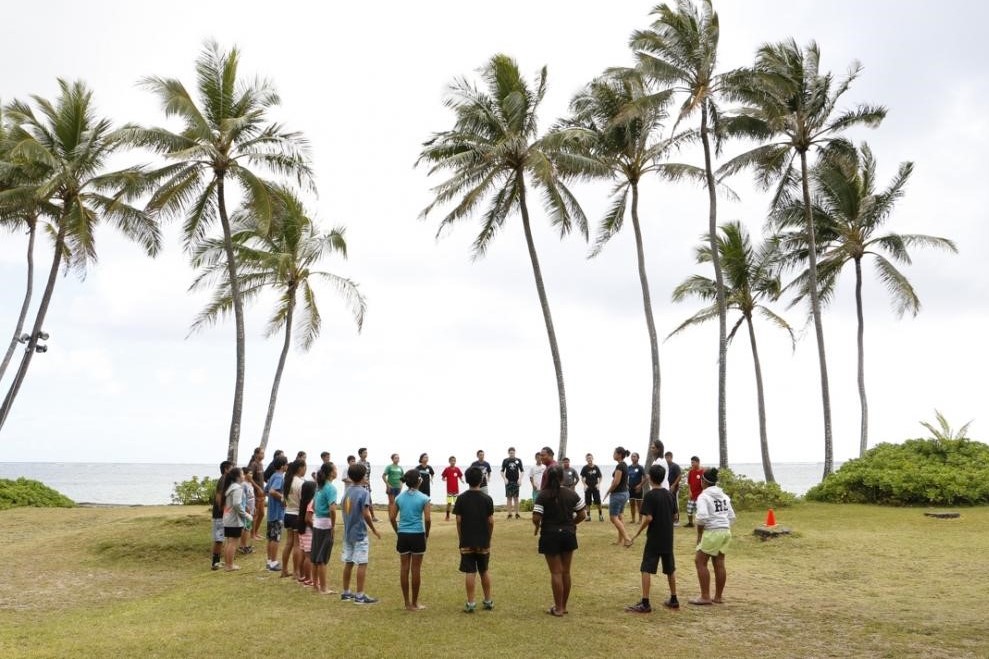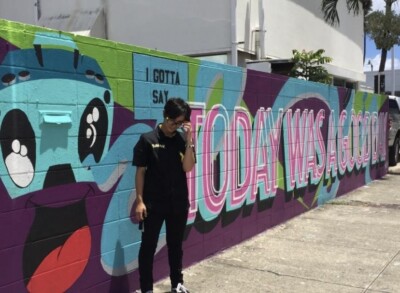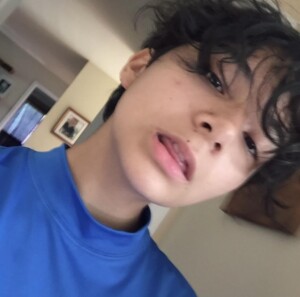HHF is pleased to share this personal reflection written by Nathan Valera, a senior at Inderkum High School in Sacramento, California. The essay was written as part of his senior independent volunteer-work project. Nathan contacted HHF with the intention of volunteering (virtually) with a community organization that aligns with his interest in perpetuating Hawaiian history and culture. He will share a second essay later this month.
Puka mai ka lā i ka wena o ke ao I ke aʻo kūpuna mālamalama
The sun rises in the rosy glow of dawn like the enlightened ways of our ancestors.
– Randie Kamuela Fong*
The sun was still tucked away in her slumber when we awoke. Excitement-filled young children who had just finished our first year of middle school, we jumped out of our sleeping mats and ran to get into a line even before our kumu instructed us to. We walked outside single file towards the beach, our feet digging into the wet dirt of the backyard before reaching the cool sand and our eyes still adjusting to the darkness around us. Barely able to see ahead, we strode forward into the calm kai (ocean), allowing the warmth of the water to envelope us like a blanket against the cool morning wind that blew against us.

“We are at a program to learn…embrace…and lead by Hawaiian cultural values,” wrote Nathan during his first Hoʻomākaʻikaʻi experience.
“All the way! Get your head under!” instructed our kumu of Kamehameha Schools’ Ho‘omāka‘ika‘i Explorations** program. Like every morning that week, we did as we were told, and lowered ourselves under the warmth. It did not always begin as easily as this though.
Curly hair was my biggest enemy growing up. I normally spent hours straightening my hair and years using hair-straightening products. The night and morning before my second year of Explorations, I straightened my hair to the straightest I could get it. I remember praying it wouldn’t rain and ruin all the work I did. I promised myself I wouldn’t get my hair wet when we swam, just so it would stay straight. You can imagine the heartbreak I felt being told, “All the way!” that first morning. Never being an outspoken child, I sulked to myself as I lowered under, my straightened masquerade washing away in the water that I had vowed not to enter.
Fully underwater, I could barely open my eyes to see the sun. I saw orange and red light glimmer against the surface above amidst the bobbing heads of the other keiki. It felt like years until we finally shot up out of the water, looking forward to the horizon. Entranced by the view, no one turned away from the sun as we heard our kumu chant out towards the water.
E ala e ka lā i kahikina
I ka moana ka moana hohonu
Pi’i ka lewa la lewa nu’u
I kahikina aia ka lā
E ala eArise, the sun in the East
From the ocean, the ocean deep
Climbing toward heaven, the highest heaven
In the east is the sun
Awaken!– Aunty Pua Kanahele
Her voice echoed out across the horizon, her powerful words enveloping us with the iʻa, the kai, the pōhaku, and the sun, as if we were all one together in one harmonious bubble. One bubble together in the kai, living and breathing together. Lōkahi is a Hawaiian value that translates best as “harmonious unity”, and in that moment, we embodied that meaning more than anything we had felt before. Although at that age, it would have been hard to define what exactly we were feeling.
It was not until years later that I truly understood the feeling of unison that I felt in the water that summer, though I had always felt drawn to it. By the end of that year in Explorations, I was more excited to spend my early morning in the kai, surrounded by the other keiki and my kumu as we immersed ourselves in the warm water. It felt as though we were connected as a community with the ocean, the sun and our entire surroundings, embraced within a bubble. Guided by our kumu’s powerful voice, we felt the bubble grow larger in capacity but closer in proximity. We felt bigger than ever before, considering each grain of sand as a part of our bubble, feeling closer to each other day by day.
When it came time to depart, it took us a few extra minutes to leave as almost everyone took one look back, to see the sun now fully risen above the horizon. I left not understanding how or why I felt that bubble, but fully aware of the connection I felt under the morning sun, submerged beneath the warmth of the calm water. I felt in harmony with the natural elements surrounding me, as though the water was one with me just as the sun and rocks and grains of sand were. Though I had left wondering what the feeling was at the time, I am now able to express it.
Growing up in California in a predominantly white area, I had come to know otherness well. I knew my own culture, but in the way so many other people of color do; through the lens of the white-dominated atmosphere. The sense of otherness derived not only from the absence of ethnic diversity among the teachers at school, the lack of cultural history or representation in my classes, and the remarks by others about skin color and hair type; but it also came from my mom being paid less than her white counterpart and my father risking his business in order to employ immigrants and help them in getting citizenship, just as he and his family received assistance from others. It was all of these incongruities together that I saw in the life around me, making me wonder, why do we live so differently? Why is it harder for us? A universal insecurity exists in people of color that has stemmed from colonization and the push of Eurocentric ideals and features, causing even young children question if they fit in; many not even realizing the source of their insecurity until much later in life. Growing up, so many people of color face discrimination for their natural appearance or cultural identity; they are shamed for speaking their native language and wearing their natural hair. As a child, I did not understand that these incongruities are what formed this insecurity, nor did I realize that these questions I had stemmed from the oppression by the dominant culture. It is harder for people of color because of the discrimination ingrained in the system all around us–not just socially, but politically and economically as well.
I hated my curly hair, and it wasn’t until after middle school that I began to connect the dots between my hair and my feelings of insecurity. I remember being told by teachers in preschool that I needed to put my hair up or brush it because it was “too informal” for school. I grew up with many kids who called my hair nappy and messy, telling me I needed to take better care of my hair. I remember many times being frustrated with my parents for constantly telling me I should appreciate my hair when everyone else around me was telling me otherwise. Those people had no idea the efforts ethnic hair took– I could not just go to the bathroom to brush my hair. It would become tangled and frizzy, which would just get me in more trouble for being “distracting.” Even I barely understood and questioned why I couldn’t be like others. Why was it harder for me? I spent years constantly straightening my hair out, buying as many straightening products as I could, begging my parents to get my hair professionally straightened before I begun to understand the consequences.
As I entered high school, I started to see the damage I was doing to my hair as it grew thinner and began to fall out. Around that time, I started to notice permed hair becoming a trend. Seeing guys all over town with permed waves and curls made me realize I could accept my hair and myself as I am. I could embrace my natural curls as a blessing, but I also became confused as to why curly hair was only celebrated when artificial. It wasn’t until 11th grade that I began wearing my hair naturally again, but it took a long year to help repair it from the damage I had done. Although my curls may never return to how they were when I was younger, I’ve learned that many, many other people of color share similar experiences like mine. Our universal struggle with insecurity is never more apparent to me than when I listen to others speak of their journeys with their natural features and how they went from being perceived as unprofessional, unkempt to being praised as trendy, and even desirable. I am left wondering again: why is it harder for us?
Kamehameha Schools’ Hoʻomākaʻikaʻi Explorations Program was one of the first experiences I had outside of my own home where my ethnic culture was important to others. That first morning, in spite of my fears, my hair was praised nonstop by other students; once dried, slightly frizzy curls hung naturally on my face. I saw other kids with similar curls who said they liked mine, who also struggled in the bathroom after to brush their hair out. This experience allowed me to begin to piece together the connection I felt to my Hawaiian roots, as I understood more and more how encompassing it is.
I was always told to be welcoming to all by my mother. She told me Hawaiians always allowed anyone in their communities, and to have open-arms for all. There weren’t any other Hawaiian children growing up around me, aside from my siblings, and though that didn’t prevent me from holding up the traditions my mother taught me, it did prove to be limiting in my complete understanding. I only had my mother to tell me about these customs and with no one else to reinforce them around me, it was hard to remember the importance of them as a child. I accounted it to my mother’s strict parenting, and just thought she used being Hawaiian as an excuse to teach me what she wanted. Through Explorations, I slowly learned this was far from the truth. I did spend a lot of my childhood in Hawaiʻi, but I didn’t understand the importance of this Hawaiian tradition until the summer experiences reminded me of the aloha and moral values that were expected from me and my brothers as children of Hawaiian blood. For every single person, aloha was expected to be given and received to everything and everyone. Every single year this expectation was upheld higher than any. I finally began to understand the true meaning of my inherited cultural values and the bond I experienced in the kai that summer.
“I continued the Hawaiian spirit of aloha by welcoming others into group activities and giving them my full attention.”
– Nathan Valera, self reflection while participating in Hoʻomākaʻikaʻi Puke
Standing there in the kai, I knew the feeling was unlike any I had felt before. I knew the water felt warmer than it ever had and the sun brighter than it had ever been. I didn’t understand why I felt moved by a chant I only half understood, nor did I realize the impact it would have on me. The connection between the world around me was not built there standing in the water, listening to my kumu chant. It was built from my childhood when I felt the aloha in my spirit rip away with insecurities of my hair. I did not know then that what was taken from me was the aloha spirit, but I grew to understand that through experiences like those I had those mornings in the kai. My mother’s teachings of aloha so early in my life built that connection despite the insecurity that tried to overpower my spirit. I did not realize then the lesson at hand in our bubble of sea and rocks and sun was the spirit and connection I was born to feel. I did not realize the bubble only represented that connection between life that extended far past my own life. This was the connection my kānaka understood and spent centuries keeping alive. Despite all of the ruins of colonialism, this connection could not die, and our kānaka made sure of that. The universe made sure of that. I could not be more grateful for the strength that this summer program gave me to keep my aloha spirit alive.
My cultural awakening taught me that the connection I have with my culture is deeper than just tradition and story. It is more than a lifestyle and though preservation helped spread this connection, it goes even deeper than that. Connection to one’s culture is a universal rule, pulling us towards it no matter what force pushes us out. My own hatred for my hair was not enough to stop the universe from putting me in that water, allowing me to be there that day. There are spiritual ties that attach us all to the land, pulling us towards understanding the deeper meaning of cultural connection. It is the product of generations of connections, building our spiritual world through the ties and forming the bubble I felt subconsciously that summer. We are all connected through these spiritual threads, just as all that is around us is, too; the sea, the sun, the people all connected and intertwined by history that makes those ties unbreakable.
I hoʻokahi kahi ke aloha
E mau ke ea o ka ʻāina i ka ponoTogether as one, one in love
We can preserve the life of the land in righteousness– William Kahino*
By Nathaniel Valera, youth volunteer November 2, 2020
*Source: Kūlia I Ka Pono: Ka Mokupuni O Oʻahu Puke
**Explorations or Ho‘omāka‘ika‘i is a one-week residential boarding program offered by Kamehameha Schools since 1968. Students entering grades 6 and 7 (who are not currently enrolled at KS) engage in hands-on learning activities and field trips focused on cultural values and practices to develop Hawaiian identity and leadership. For information about this and other Kamehameha Schools’ Community Education programs, visit: https://apps.ksbe.edu/communityed.




